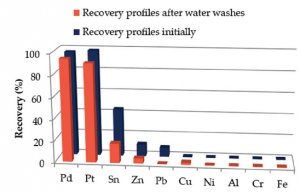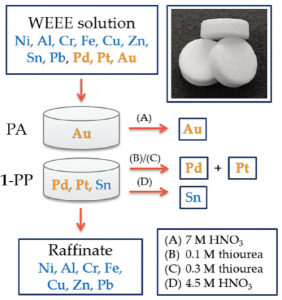In 2010, around 28 million tons of e-waste were discarded, and it is estimated that this quantity increases by 5-10% every year. This massive volume contains untold riches in precious metals. As a result of this, research efforts to design practical metal recovery techniques from e-waste are being ramped up internationally.
A range of techniques have been developed, these include hydrometallurgical and mechanochemical protocols. Researchers from Finland have recently added another method to the mix, developing a 3D printed filter for isolating palladium and platinum.

Metal recovery by the filter.
The team built the filter by crushing up a specially designed resin into powder, and mixing it with polypropylene. This mixture is then printed into shape using a commercially available, selective laser sintering 3D printer.
The filter was tested by examining its performance on an aqueous mixture of common metals. The filter absorbed 96% of the palladium and 98% of the platinum in the solution (see figure at left). Most of the other metals passed through the filter, but a little bit of tin, zinc and lead were also present.
In order to re-use the metals, it is important to be able to purify them. With this in mind the team washed the filter with water, removing the tin, zinc and lead. The palladium was then extracted by washing the filter with a salt solution, a second salt solution removed the platinum. After isolating the metals, the filter could be reused without any significant loss of function.
The final experiment performed by the team, tested the maximum amount of metals that the filter could absorb. The filter capacity was comparable to the raw powdered ingredients, showing that the printing process does not damage the activity of the metal absorbing resin.
The authors hope that this technique might find practical application in recycling precious metals from e-waste. Given, the simplicity of the design they also put this invention forward as a useful metal scavenger in other domains.

Isolation protocol in flow

















